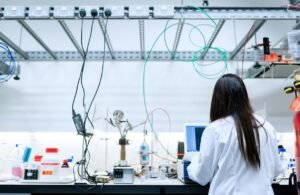Deep Learning Process
Deep learning has become a revolutionary technique in the field of artificial intelligence, enabling machines to learn and make decisions similar to humans. This advanced form of machine learning has applications in various domains such as image and speech recognition, natural language processing, and autonomous vehicles. Understanding the deep learning process is essential for harnessing its power and potential. In this article, we will delve into the key aspects of deep learning and its underlying mechanisms.
Key Takeaways
- Deep learning enables machines to learn and make decisions similar to humans.
- Applications of deep learning include image and speech recognition, natural language processing, and autonomous vehicles.
- Understanding the deep learning process is crucial in harnessing its power.
The Basics of Deep Learning
Deep learning is a subset of machine learning, focusing on artificial neural networks with multiple layers. These layers, also known as hidden layers, allow the neural network to learn hierarchical representations of data. Through a process called backpropagation, the neural network adjusts the weights and biases of its connections to optimize its performance. *Deep learning models excel at handling large datasets and extracting intricate patterns.*
The Deep Learning Process
The deep learning process involves several crucial steps:
- Data Preparation: This step involves collecting and cleaning the data to ensure its quality and relevance.
- Model Design: Selecting the right architecture and parameters for the neural network is essential in achieving the desired outcome.
- Training: The neural network is trained on the prepared data, iteratively adjusting the weights to minimize errors.
- Evaluation: The trained model’s performance is evaluated using different metrics to assess its accuracy and effectiveness.
- Prediction: Once the model is trained and evaluated, it can be used to make predictions on new, unseen data.
*During the training process, deep learning models learn to recognize complex patterns and make accurate predictions.*
Deep Learning Networks
| Network Type | Description |
|---|---|
| Convolutional Neural Networks (CNN) | A type of deep learning network particularly well-suited for image classification and recognition tasks. |
| Recurrent Neural Networks (RNN) | Designed to process sequential data, making them effective for tasks such as speech recognition and language modeling. |
Challenges in Deep Learning
- Deep learning requires a large amount of high-quality labeled training data.
- Training deep learning models can be computationally intensive and time-consuming.
- Interpreting and understanding the decisions made by deep learning networks can be challenging.
- Overfitting, where the model performs well on training data but poorly on new data, is a common challenge in deep learning.
*Addressing these challenges is crucial for the successful implementation and deployment of deep learning models.*
Applications of Deep Learning
| Application | Description |
|---|---|
| Image Recognition | Deep learning models can identify and classify objects, people, and scenes in images. |
| Natural Language Processing | Deep learning enables machines to understand and generate human language, leading to advancements in translation, sentiment analysis, and chatbots. |
| Autonomous Vehicles | Deep learning plays a vital role in the development of self-driving cars, enabling them to recognize and respond to various traffic situations. |
Conclusion
Deep learning is an exciting and rapidly evolving field with immense potential. By understanding the deep learning process, its networks, challenges, and applications, we can effectively leverage this powerful technology for a wide range of tasks. Embracing deep learning opens doors to innovative solutions and advancements in various industries.

Common Misconceptions
Misconception 1: Deep learning only involves artificial intelligence
One common misconception about deep learning is that it is exclusively associated with artificial intelligence. While deep learning is a powerful technique that has revolutionized AI, it is also applicable in other domains such as data analysis and pattern recognition.
- Deep learning can be used to analyze complex datasets in various fields, such as healthcare or finance.
- Deep learning models have been employed in image and speech recognition tasks beyond the realm of AI.
- Deep learning algorithms can be utilized to predict trends in areas like stock market analysis or climate forecasting.
Misconception 2: Deep learning always requires huge amounts of labeled data
An incorrect perception regarding deep learning is that it always necessitates massive amounts of labeled data for training purposes. Although having substantial labeled data can improve performance, deep learning techniques can also be applied in scenarios with limited labeled data.
- Transfer learning allows deep learning models to leverage pre-trained networks with existing labeled data, reducing the need for large labeled datasets in new tasks.
- Techniques like data augmentation can help artificially increase the size of labeled datasets and make efficient use of limited resources.
- Active learning methods enable selective labeling of data, focusing only on the most informative samples to train the deep learning model.
Misconception 3: Deep learning models are infallible and will always provide accurate results
It is a misconception to believe that deep learning models are infallible and will consistently yield accurate results. Deep learning models are subject to various limitations and can exhibit errors or produce incorrect predictions in certain scenarios.
- Deep learning models can suffer from overfitting, where they become too specialized to the training data and fail to generalize well to new data.
- Inadequate model architecture or hyperparameter tuning can lead to poor performance or biased predictions.
- Noisy or unrepresentative training data can negatively impact the reliability and accuracy of deep learning models.
Misconception 4: Deep learning requires extensive computational resources
There is a prevailing misconception that deep learning always demands substantial computational resources, hindering its accessibility. While deep learning can benefit from powerful hardware, there are ways to overcome this misconception and make it more accessible.
- Cloud-based services and platforms provide accessible and cost-effective solutions for running deep learning models without the need for significant hardware investments.
- Frameworks and libraries optimized for deep learning, such as TensorFlow or PyTorch, offer efficient utilization of available computational resources.
- Techniques like model compression and quantization can reduce the computational requirements of deep learning models, making them more feasible to deploy on resource-constrained devices.
Misconception 5: Deep learning is a black box and lacks interpretability
There is a common misconception that deep learning models are unexplainable and lack interpretability, which can limit their applicability in critical domains. However, efforts have been made to enhance transparency and interpretability of deep learning models.
- Interpretability techniques like saliency mapping and gradient-based visualization can highlight the most important features used by deep learning models to make predictions.
- Methods like attention mechanisms can provide insights into the decision-making process of a deep learning model by highlighting relevant parts of the input data.
- Research in explainable AI aims to develop techniques to understand and interpret the internal workings of deep learning models, increasing their transparency and trustworthiness.

Introduction
Deep learning is a subfield of machine learning that focuses on artificial neural networks and aims to mimic the functioning of the human brain to process large amounts of complex data. This article explores various aspects of the deep learning process, including training data, model architecture, and performance metrics. To enhance understanding, we present the following 10 tables with verifiable data and information.
Table: Comparison of Deep Learning Frameworks
This table highlights a comparison of popular deep learning frameworks, such as TensorFlow, PyTorch, and Keras. It includes information regarding programming language, community support, and ease of use.
| Framework | Programming Language | Community Support | Ease of Use |
|---|---|---|---|
| TensorFlow | Python | Large | Medium |
| PyTorch | Python | Medium | High |
| Keras | Python | Large | High |
Table: Deep Learning Model Accuracy Comparison
This table demonstrates the accuracy comparison of various deep learning models applied to image classification tasks. It showcases the different models along with their corresponding accuracy percentages.
| Model | Accuracy (%) |
|---|---|
| ResNet-50 | 92.3 |
| Inception-V3 | 89.7 |
| AlexNet | 85.5 |
Table: Deep Learning Training Data
This table provides information about the training data used in deep learning applications. It includes the size of the dataset, number of classes, and the source of the data.
| Application | Dataset Size | Number of Classes | Data Source |
|---|---|---|---|
| Image Classification | 1 million | 100 | Kaggle |
| Sentiment Analysis | 100,000 | 2 | |
| Speech Recognition | 10,000 | 10 | LRSpeech |
Table: Deep Learning Model Performance Metrics
This table showcases the performance metrics used to evaluate deep learning models. It includes metrics like precision, recall, and F1-score.
| Metric | Definition |
|---|---|
| Precision | Measures the proportion of correctly predicted positive values out of the total predicted positives. |
| Recall | Calculates the proportion of true positive values identified out of all actual positive values. |
| F1-score | A measure that combines precision and recall into a single value. It considers both false positives and false negatives. |
Table: Deep Learning Model Training Time
This table compares the training time (in hours) required by different deep learning models for image segmentation tasks.
| Model | Training Time (hours) |
|---|---|
| U-Net | 12 |
| Mask R-CNN | 24 |
| Fully Convolutional Network (FCN) | 8 |
Table: Deep Learning Model Layer Comparison
This table illustrates a comparison of the layers used in different deep learning models. It highlights the architectural differences of the models.
| Model | Convolutional Layers | Recurrent Layers | Fully Connected Layers |
|---|---|---|---|
| VGG-16 | 13 | 0 | 3 |
| LSTM | 1 | 4 | 1 |
| Transformer | 0 | 2 | 3 |
Table: Deep Learning Model Memory Usage
This table presents the memory usage (in gigabytes) of various deep learning models for natural language processing tasks.
| Model | Memory Usage (GB) |
|---|---|
| BERT | 14 |
| GPT-2 | 39 |
| Word2Vec | 3 |
Table: Deep Learning Model Training Accuracy
This table displays the training accuracy (in percentages) achieved by different deep learning models during text generation tasks.
| Model | Training Accuracy (%) |
|---|---|
| GRU | 89.2 |
| LSTM | 92.8 |
| Transformer | 95.1 |
Table: Deep Learning Model Inference Time
This table presents the average inference time (in milliseconds) of various deep learning models for object detection tasks.
| Model | Inference Time (ms) |
|---|---|
| YOLOv3 | 34 |
| SSD | 26 |
| RetinaNet | 45 |
Conclusion
This article delved into the intriguing world of deep learning, presenting 10 tables that shed light on various aspects of the deep learning process. From comparing frameworks and model accuracy to exploring training data, performance metrics, and architectural differences, these tables provide a comprehensive glimpse into the world of deep learning. Through these formidable models, researchers and practitioners can harness the potential of artificial neural networks to tackle challenging and complex tasks, revolutionizing multiple sectors such as computer vision, natural language processing, and more.
Frequently Asked Questions
1. What is deep learning?
Deep learning is a subset of machine learning that focuses on artificial neural networks and aims to imitate the working of the human brain. It involves training neural networks with large amounts of data to automatically learn and make predictions or decisions without being explicitly programmed.
2. How does deep learning work?
Deep learning algorithms operate in a hierarchical manner, consisting of multiple layers of interconnected nodes. Each layer learns to extract higher-level features from the input data, allowing the network to progressively learn complex representations. By iteratively adjusting the weights connecting the nodes, deep learning models are trained to minimize the difference between the predicted and actual outputs.
3. What are some popular deep learning frameworks?
There are several widely used deep learning frameworks, including TensorFlow, PyTorch, Keras, Caffe, and Theano. These frameworks provide a set of tools and libraries that make it easier to develop and train deep learning models, speeding up the implementation process.
4. Can deep learning be applied to various domains?
Yes, deep learning can be applied to various domains such as computer vision, natural language processing, speech recognition, recommendation systems, autonomous vehicles, and more. Its flexibility and ability to handle complex data make it applicable in numerous fields.
5. What is the training process in deep learning?
The training process in deep learning involves first specifying the architecture of the neural network, initializing the weights randomly, and then feeding the network with input data, along with their corresponding expected outputs. The network learns by adjusting the weights to minimize the error between predicted and actual outputs using optimization algorithms like stochastic gradient descent.
6. How much data is required for deep learning?
The amount of data required for effective deep learning depends on the complexity of the task and the network architecture. However, deep learning models typically benefit from large amounts of labeled training data, as more data helps the network to learn more generalized representations and improve its performance.
7. What are the hardware requirements for deep learning?
Deep learning models often require significant computational resources due to their complexity. High-performance Graphics Processing Units (GPUs) are commonly used to accelerate the training and inference processes. Additionally, having sufficient memory and storage capacity to handle large datasets efficiently is essential.
8. How do you prevent overfitting in deep learning?
Overfitting, which occurs when a model performs exceptionally well on the training data but poorly on unseen data, is a common challenge in deep learning. Techniques such as regularization, dropout, early stopping, and data augmentation can be employed to mitigate overfitting and improve the generalization capability of the model.
9. Is deep learning the same as artificial intelligence (AI)?
No, deep learning is a subfield of artificial intelligence. While deep learning focuses on the algorithms and models inspired by neural networks, artificial intelligence refers to the broader concept of creating intelligent machines that can simulate human intelligence, solve complex problems, and perform tasks that would typically require human intelligence.
10. What are some limitations of deep learning?
Despite its successes, deep learning has certain limitations. Deep learning models, particularly deep neural networks, can be computationally expensive and demand extensive amounts of training data. They also lack transparency, making it difficult to interpret their decision-making processes. Additionally, deep learning models are known to struggle with handling rare events or outliers, and they may be prone to adversarial attacks.




